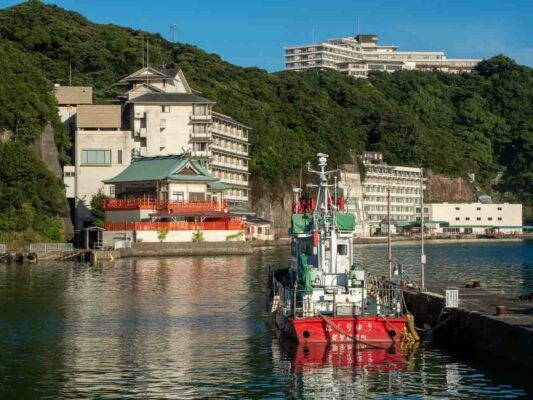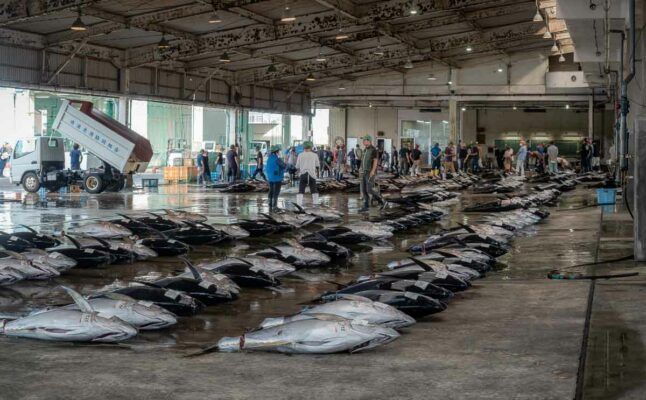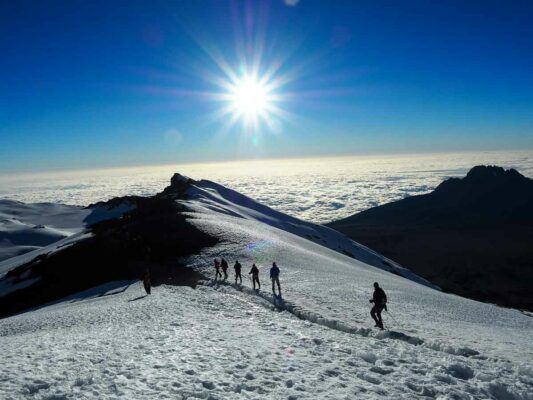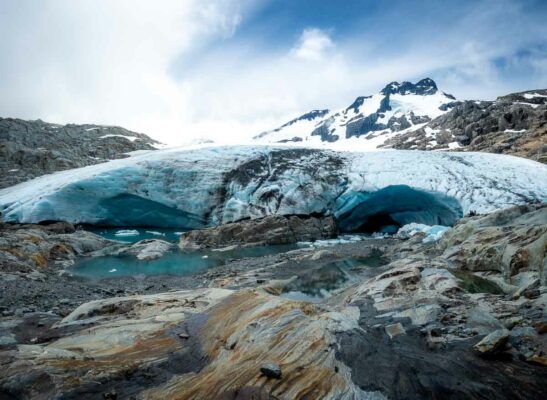No products in the cart.
Destinations, Kilimanjaro, Money
Kilimanjaro Park Fees 2024 (This Is How They’re Calculated)
Climbing Kilimanjaro is not cheap. When I was planning my trip back in 2019, the shock of the various fees caught me off guard. These include the conservation, camping, rescue, guide, and porter fees.
If that’s not enough, I also had to factor in my preferred route, the tour operator I’d be employing, and the equipment needed. But that’s a post for another day.
In essence, one of the biggest expenses you’ll face is the Kilimanjaro park fees. These are payable to the Kilimanjaro National Park Authority (KINAPA) for entering the park and using its facilities.
At first glance, it all seems confusing.
But I’ll help you understand how the Kilimanjaro park fees are calculated, what they cover, and how they vary by route. Hopefully, by the end of this post, you’ll have a clear idea of how much you need to budget for your adventure.
Table of Contents
How Much Are The Kilimanjaro Park Fees?
After summiting Mount Kilimanjaro in 2019, one of the most common questions I get from family and friends interested in climbing the mountain is how much it costs to enter the park.
The answer is not so simple. It depends on several factors.
Although the main cost is the park fees, you need to take into account the route of your climb, the duration of your stay, and whether you’ll be camping or staying in a hut.
Fees are set by the Kilimanjaro National Park Authority (KINAPA), and include the following items:
Conservation fees
This is a daily fee that covers the park’s conservation efforts. It’s $70 per person per day for foreign non-residents and helps to fund the park’s operations. These include ranger patrols, anti-poaching activities, wildlife management, fire prevention, infrastructure development, and environmental education.
Camping fees
For every night spent on the public campsites on the mountain, you’ll pay $50 per person per night. This does not include the Marangu route, which has huts instead of campsites.
Hut fees
To cover the use of the dormitory-style huts on the Marangu route, expect to pay $60 per person per night.
Rescue fees
A one time fee that covers the cost of emergency evacuation from the mountain in case of illness or injury. It’s $20 per person and should be paid whether you get rescued or not.
Crater camping fees
This optional fee covers the use of the special campsite at the crater rim. It’s $100 per person per night for all climbers.
Guide and porter entrance fees (crew fees)
A daily fee that covers the entrance of your guides and porters into the park. It’s only $2 per person per day for all crew members.
Children under 16
Children under the age of 16 are eligible for a discount on the conservation fee, camping fee, and hut fee, regardless of their citizenship status. They are charged $10 for the park fees but still have to pay the full amount for the rescue fee, crater camping fee, and guide and porter fee.
Tanzanian residents and expats
As a Tanzanian resident or expat, you’re eligible for a 90% discount on the conservation fee, camping fee, and hut fee. You’ll still need to pay the full amount for the rescue fee, crater camping fee, and guide and porter entrance fee.
East African citizens
As a means of encouraging regional tourism, East African citizens are also exempt from paying the full price. They’ll only be charged 10, 000 Tanzania shillings if they’re above the age of 16, and 5, 000 Tanzanian shillings between the ages of 5 and 15. Where rescue fees are concerned, they’re only expected to pay 2,000 Tanzanian shillings.
To qualify for this rate, you’ll have to provide a valid passport or national ID card from one of the following countries:
- Tanzania
- Kenya
- Uganda
- Rwanda
- Burundi
- South Sudan
Value Added Tax
On top of all these fees, you’ll need to pay 18% VAT imposed by the Tanzanian government. This rate applies to all climbers.
Park Fees For Hiking Each Route
Each route has a different number of days and nights on the mountain. The shorter the route, the lower the expenditure, and vice versa.
NOTE: These fees are subject to change. As mentioned, they are set by the Kilimanjaro National Park Authorities (KINAPA). Your best bet is to check their website for regular updates.
Here’s a table summarising the park fees for each route, based on a standard itinerary.
| Route | Days | Nights | Conservation Fees | Camping Fees | Hut Fees | Rescue fees | Total |
|---|---|---|---|---|---|---|---|
| Marangu (Coca-Cola Route) | 5 | 4 | $350 | $0 | $240 | $20 | $610 |
| Machame (Whiskey Route) | 6 | 5 | $420 | $250 | $0 | $20 | $690 |
| Lemosho | 8 | 7 | $560 | $350 | $0 | $20 | $810 |
| Rongai | 6 | 5 | $420 | $250 | $0 | $20 | $690 |
| Shira | 6 | 5 | $420 | $250 | $0 | $20 | $690 |
| Umbwe | 6 | 5 | $420 | $250 | $0 | $20 | $690 |
| Northern Circuit | 9 | 8 | $630 | $400 | $0 | $20 | $1050 |
If you want to add an extra day for acclimatization or crater camping, you’ll pay an additional $120 per day for conservation and camping fees. If you opt for crater camping, expect to pay an extra $100 per night.
How To Calculate The Park Fees?
Follow these steps to calculate the park fees for your climb.
- Choose your route and the number of days and nights of your stay.
- Multiply the cost of conserving the park by the number of days on the mountain.
- Multiply the camping or the hut fees by the number of nights spent in the park.
- Add the rescue fees.
- Multiply the crew fees by the number of days on the mountain. 1 guide and 3 porters per climber is the common ratio.
- Add the fees.
- Add 18% VAT to the total amount.
Want to see these numbers in action?
Let’s assume you’re planning on climbing the Lemosho 8-day route. Here’s what you should expect to pay:
- Conservation fees: $70 x 8 = $560
- Camping fees: $50 x 7 = $350
- Rescue fees: $20 x 1= $20
- Crew fees: $2 x 4 = $8
- Subtotal: $938
- VAT: $168.84
- Total: $1,106.84
As you can see, the park fees are not cheap and can add up to a significant amount. When you take into account other expenses like flight tickets, visa fees, travel insurance, rental equipment, tips, and extras, you soon realise that careful budgeting is a must.
How To Pay The Park Fees?
Your tour operator takes care of everything for you and you don’t have to pay directly to KINAPA. These fees are automatically included in the price of your climb package and are paid online through the TANAPA Online Reservation System. This means you don’t have to deal with any hassle or paperwork, and you can focus on enjoying your adventure.
Can I pay the park fees to KINAPA directly?
Paying directly to KINAPA instead of paying a tour operator may seem like a cost-effective technique that can help you avoid potential scams.
But the agency requires park fees to be paid through licensed tour operators or travel agencies. Direct payments to KINAPA are not accepted.
If you’re planning to hike Kilimanjaro, it’s best to book your trip through a registered tour operator.
Summary
Climbing Kilimanjaro can be pricey, especially when you factor in all the fees. But the fees are an essential part of conserving the park, assisting you in an emergency, and ensuring you overnight in decent accommodation. While climbing Kilimanjaro involves some costs, understanding these fees lets you plan better.
Bear in mind also that different routes have different costs, and extra days or special camping options can inflate your expenditure.
Although it makes sense to pay directly to KINAPA, they unfortunately do not accept direct payments. A safer option is to employ a licensed tour operator. They’ll do the heavy lifting to ensure you have a fun, safe, and memorable experience by including these rates in your climb package.
Kilimanjaro Travel Planning Cheatsheet
🚑 Should I buy travel insurance for Tanzania?
100% YES! — Tanzania has now introduceed “free” healthcare but it’s only for citizens! Tourists need travel insurance in case anything happens on your visit. Also be aware many policies won't cover high altitude hiking as it's a high risk activity!
(that's right, check the t&c's on your complimentary credit card insurance)
I highly recommend World Nomads as you can get specific add-ons for high altitude hiking UP TO 6000m (Which most travel insurance companies don't offer!)
🎫 Do I need a visa for Tanzania?
Probably not — Tanzania now provide a visa on arrival (VoA) for most western countires which allows you stay for up to 90 days. However, some other countries do need a pre-approved eVisa (check here!). VoAs cost $50 USD for a single entry - Note, US Citizens are required to get a Multi-Entry visa which costs $100 USD. (View visa prices here)
If transiting through Kenya (a lot of people fly via Nairobi), you'll need a Kenyan visa too. Visa's cost $20 for a 3 day transit visa and $50 for a toursit visa
(By the way, on both my interactions with the imigration officers in kenya they tried to scam me, so know what your obliged to pay and BRING THE EXACT CASH for the visa!)
💉Do I need any vaccinations for Tanzania?
YES! Make sure you are up-to-date with all your vaccines. Common travel vaccines include Hep A/B + Typhoid, and Diphtheria + Tetanus.
A yellow fever vaccination isn't a requirment to visit Kilimanjaro but is for neighbouring areas in East Africa. In reality, you will might not be allowed back into your home country on your return (I was asked for proof of vaccination upon returning to Australia) so getting this jab prior made for good peace of mind.
Rabies is an issue in Tanzania but the vaccine is expensive and ineffective as a preventative measure (it only lasts a few years and you'll need to get them again if you require treatment). If bitten by a stray dog seek immediate medical attention!
As always, talk to your GP or specialised travel doctor a few weeks BEFORE you leave.
🏩 What’s the best Kilimanjaro Tour operators?
Your only realy two options here are Kumano Travel and Booking.com. Its a complicated process so I wrote this guide here on the best kumano kodo accomodation options
If you don't want to figure it all out (it's meant to be a holiday after all) you can book a package tour. Here are my recommendations for both guided and self-guided.
💸How do you pay for things in Tanzania?
Cash is king in Tanzania, so you'll want to get some folding tender out from an ATM when you land. Larger businesses and hotels will take Debit / Credit Card but most resturants, and street vendors want cash. I even had to pay for my Kili trip in cash!
I personally use a Wise debit card for all my international money needs as they only convert the funds when you make payment, plus they offer a much better spread (margin on the true exhange rate) than the banks do. They work in all the Tanzanian ATMs I tried.
🚌 What's the public transport like in Tanzania?
There is a good basic network of local and inter-city busses in Tanzania and travel this way is very cheap. Domestic flight are also very affordable and a far more comfortable option. Checkout Busbora for booking bus tickets online.
📲 How do I get internet/data/wifi in Tanzania and on the mountain?
This one needs a whole nother article, but the short version is prepaid SIM cards are cheap and availible to tourists and locals alike (You don't need a pricey tourst SIM!)
Your cheapest option is buying a physical sim card on the street corner once landed and getting the shop assistant to help you set it up. I went with Vodacom and had generally good coverage, even up on Kili!
Another option if you're visiting other African countries is the Nomad eSIM. This is a little more expensive but gives you connectivity across 14 neighbouring African Countries!
✈️ What’s the best site to buy flights to Tanzania?
For finding cheap flights, I recommend Skyscanner. Once you find the flight you're looking for, I'd then suggest booking directly with the carrier (even if it costs a few $$ more than with one of the agreggators/agencies).
💧Can you drink the water in Tanzania?
Safest not to — tap water in Tanzania may be OK (the locals drink it) but is generally untreated and not reccommended for tourists. Purchase bottled water for drinking and teeth brushing.
🏔️💧Can you drink the water on Mount Kilimanjaro?
Yes — Your tour company with ensure the water provided to you is safe to drink by either carrying in bottled water, or by treating stream water with purification tablets or by boiling it. If you want to drink water from the rivers and streams you generally can but should do so at your own risk. ALWAYS follow best practice and drink from fast flowing water as far up stream as possible. I'd also recommend a Brita Water Bottle for rehydrating on the trail safely.







